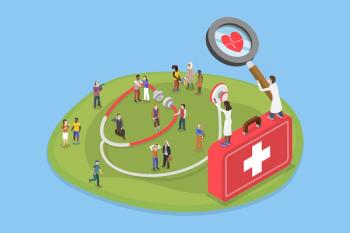
- June 2017
- Volume 23
- Issue SP7
Do What I Couldn't…and Go Save Your Life
Amy Byer Shainman narrates how the knowledge that she was BRCA1 positive led to her decision to undergo prophylactic surgery.
BRCA: The Basics
— Ellen Matloff, MS, CGC, CEO, My Gene Counsel
Every cell in our body contains 23 pairs of long, thin structures called chromosomes. We inherit 1 chromosome of each pair from our mother, and the other from our father. Most mutations in the BReast CAncer susceptibility genes (BRCA) are inherited from the mother or father, rather than representing new (or de novo) genetic changes. This means that at some point in time, the DNA of a relative changed or mutated and that genetic change has been passed down through the generations.Our genetic information is stored on our chromosomes in tiny units called genes. We have tens of thousands of genes that help code for everything about our bodies: from eye color to hair color to disease risks. We all have 2 copies of BRCA1, 1 on each of our two #17 chromosomes. A woman who inherits 1 mutation in BRCA1 is at an increased risk of developing both breast and ovarian cancer, while a man who carries a BRCA1 mutation is at an increased risk for breast and prostate cancer. BRCA2 is located on chromosome 13, and we all have 2 copies of this gene. Women with 1 BRCA2 mutation are at an increased risk of developing breast, ovarian, and pancreatic cancer while men who carry 1 BRCA2 mutation are at an increased risk of breast, prostate, and pancreatic cancer.
No one could believe my sister Jan’s ovarian cancer was an early stage, contained cancer. How could Gilda Radner’s grapefruit-sized ovarian cancer be stage IV and Jan’s grapefruit-sized ovarian cancer be stage I? Another surprise was that Jan’s final pathology indicated, besides stage IC ovarian cancer, that she also had stage 1B uterine cancer. Her surgeon recommended she undergo 6 rounds of chemotherapy to make sure all the cancer was gone.
A year later, in the fall of 2009, life was slowly getting back to normal for my sister and our family. When Jan found out there was an ovarian cancer conference in Las Vegas, she had a feeling she should go to learn more. Her take-home message from the conference was: “Get genetic testing for B-R-C-A mutations!” Why? Because she learned she had many red flags:
- She was of Ashkenazi Jewish descent
- She had 2 primary cancers at the same time (uterine cancer and ovarian cancer)
- She was younger than 50
- There was a family history of breast cancer on our dad’s side of the family
With her newfound knowledge, my sister made an appointment with a certified genetic counselor at the hospital where she was treated.
— Jan Byer
It turned out that I was BRCA1 positive. All that I could think about was my sister Amy. Then, the genetic counselor informed me that ALL my siblings needed to be tested, not just my sister, but my brothers, too.
Although I didn’t know exactly what genetic testing would mean for me specifically, I knew that the outcome of my own genetic testing results was going to have an impact on my future. So, I started maintaining a journal, not just for myself, but also for my kids and for future generations of my family. Moreover, I felt in my gut that there was an opportunity for me to help others gain insight from my experience.
As a strong woman, I felt if I could get actionable, helpful information regarding my health, I needed to get it. As a mom, I felt a parental responsibility to not bury my head in the sand, to meet with a certified genetic counselor.
— Maya Angelou
When women take care of their health, they become their own best friend.
About 3 weeks after meeting with a certified genetic counselor and having my blood drawn for genetic testing, I discovered I was positive for a BRCA1 gene mutation, too. The certified genetic counselor referred me to see a medical oncologist who specialized in high-risk patients. I was immediately compelled to share my genetic testing results in an e-mail to a few close friends and, of course, to my family, especially since many of them could be at risk, too. This is what I wrote:
—Amy
Family & Friends:Unfortunately, I tested positive for the BRCA1 gene mutation #5385 (also known as #5382), the same gene mutation as Jan. It’s 1 of the 3 BRCA mutations associated with people of Ashkenazi Jewish descent. It’s most definitely what dad’s mom Lillian had and eventually died from...Jon and I will meet with a medical oncologist who specializes in genetic patients at high risk for breast and ovarian cancer in the next few weeks. I may have some major decisions to make regarding my female reproductive organs.
— Ellen Matloff, MS, CGC, CEO, My Gene Counsel
There are 3 specific mutations deemed “founder mutations” that are more common in people of Ashkenazi Jewish descent. Approximately 1 in 43 Ashkenazi Jews carry a BRCA mutation.
Jon and I didn’t thoroughly understand exactly what having this genetic mutation meant for me, but we did realize that this information was about to lead my life, our marriage, and our family down a different path. As I actively began researching BRCA, neurosis kicked in and I found myself constantly thinking about my breasts. A few times every day I would feel my breasts, checking them for lumps. All the visuals in my life suddenly became about my breasts: making breakfast, 2 eggs sunny side up; driving in my car I’d see a bicyclist, the 2 wheels on the bicycle riding down the street; change for a dollar at the store, 2 quarters. Any image with 2 circles and breasts was all I could see.
— Siddhartha Mukherjee, MD, DPhil, in his book, The Gene
The future of a woman carrying a BRCA mutation (or any other hereditary cancer syndrome) is fundamentally changed by that knowledge—and yet it remains just as fundamentally uncertain. For some women, the genetic diagnosis is all consuming. It is as if their lives and energies are spent anticipating cancer and imagining survivorship—from an illness they have not yet developed. A disturbing new word, with a distinctly Orwellian ring, has been coined to describe these women: “previvors”—pre-survivors...the prophylactic treatments…mastectomy, hormonal therapy—all entail physical and psychological anguish and carry risks in their own right.
My annual checkup would now include a transvaginal ultrasound, even though transvaginal ultrasounds aren’t 100% effective at detecting ovarian cancer. In addition, I would alternate every 6 months having a mammogram with a breast ultrasound and breast magnetic resonance imaging. I was aware it was important to get these tests done, but nonetheless, I had major anxiety. Knowing my genetic status was so all-consuming that I wished I could just “check out” for several weeks while processing all the information and hook myself up to a Prozac drip. However, I was a mom and there was the matter of taking care of the kids, so checking out for me was not an option.
My medical oncologist, Elisabeth McKeen, MD, FACP, gave me a rundown on my situation:
1. To reduce breast cancer risk:
- Enhanced surveillance/monitoring
- Medication: tamoxifen (lacks sufficient research on whether it is good for hereditary cancers)
- Prophylactic surgery. Removing breasts reduces a person’s cancer risk by 95%, and my doctor believes it’s more likely 98% when you have a surgeon who is aggressive in removing breast tissue. Plus, it’s better to place breast implants behind the muscle, so any future issue (cancer) is much easier to feel/detect.
2. To reduce ovarian cancer risk:
- Enhanced surveillance is, unfortunately, not effective at this juncture, and it is highly recommended that BRCA1 carriers have their ovaries removed between ages 35 to 40 or after childbearing is complete. My situation warranted a full hysterectomy as my sister Jan also had uterine cancer, which meant that I now had a “family history” of uterine cancer in a first-degree relative. Removing ovaries before natural menopause also reduces your breast cancer risk by 50%.
- There may be some benefit with the use of birth control pills.
3. Melanoma. McKeen sees many BRCA patients with melanoma and recommends an annual dermatological exam and formal eye exam, as melanoma can also manifest in the eye.
4. A colonoscopy at 50 years.
5. BRCA1 in men. My doctor admits that doctors may not be well versed or have any knowledge about BRCA1. She has seen men with the BRCA1 gene mutation develop prostate cancer and advises BRCA1-positive men to start full prostate exams by age 40.
6. Psychologist. The protocol demands that I need to see a psychologist, as there are ramifications to undergoing these prophylactic surgeries. My daughter also needs to consider certified genetic counseling and genetic testing by age 25. At 25, BRCA-positive women need to consider starting enhanced breast screenings. My son needs to consider genetic counseling and genetic testing by age 40 as that is when he would need to start full prostate exams.
The therapist I was required to see before surgery said one thing, which stuck with me: “Make sure you are at peace with your decision—whatever that is. Once it is done, it is done. Once they roll you into surgery, there is no going back. You have to make sure you are at peace with whatever you decide.”
I was told my individual lifetime risk for ovarian cancer was as high as 50%. For me, I could not gamble with the silent thunder of that disease, especially since there are still no accurate surveillance methods to detect it. I knew deep inside that my sister was lucky. I couldn’t play Russian roulette with my life. I had to do what was in my best interest—remaining breathing.
In the pre-op area awaiting my oophorectomy and hysterectomy, the gravity of what I was about to do hit me hard. I was not going to be able to have any more children. The thought of jumping up out of the bed and running out of the hospital more than crossed my mind. However, something was holding me down. Both a physical and emotional weight, an arm on my thigh, was not letting me get up, and a voice was keeping me there saying I needed to do this now, it was not a good idea for me to wait. Although she died at age 33 in 1934, my grandmother Lillian’s presence was right there in the room. Her message to me was loud and clear:
This is what you need to do to be here, Amy. You need to do this to live. Do what I couldn’t...and go save your life.AUTHOR INFORMATION
Amy Byer Shainman, otherwise known as @BRCAresponder on Twitter and social media, educates others about hereditary cancer via many social media platforms and national media placements. As a passionate advocate, Shainman shares her own BRCA story, offers support, and emphasizes the importance of certified genetic counseling in the genetic testing equation.
Reprinted with permission from Archway Publishing, a division of Simon & Schuster.
ADDRESS FOR CORRESPONDENCE
Amy Byer Shainman
PMB 200
4300 S. US Hwy. 1, Suite 203
Jupiter, FL 33477
E-mail: thebrcaresponder@earthlink.net.
Articles in this issue
over 8 years ago
Medical World News, June 2017over 8 years ago
AJMCtv® Interviews, June 2017over 8 years ago
The Transition to Integrate Palliation in Cancer Careover 8 years ago
Transitions of Care in Patients With Cancerover 8 years ago
Conference Coverage: COAover 8 years ago
Conference Coverage: NCCNNewsletter
Stay ahead of policy, cost, and value—subscribe to AJMC for expert insights at the intersection of clinical care and health economics.













































